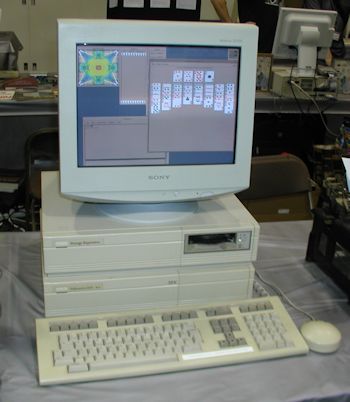Chase lights program for IMSAI 8080
SHARE |
|
  Chase lights program for IMSAI 8080
Chase lights program for IMSAI 8080 |
by Bill Degnan - 05/15/2010 19:34 |
|
Here's a program you can toggle into your IMSAI 8080 that should
display the "chase the lights" effect in your programmed output section. Text edit suggestions by Andy Meyer and Bill Dromgoole, program suggestion by Mike Loewen. First, turn on your IMSAI and toggle the STOP switch, them the RESET switch, then STOP again. Second, flip all of the data switches down and flip the Examine switch up. (This says "I want to work with address location 0000") Third, enter the following instructions into memory. (NOTE: DEPOS is a bi-directional momentary switch - it will not stay up or down. When you flip the switch up, you're telling the computer to deposit a value into the memory location you EXAMINE(d). When you flip it down, you're telling the computer to deposit a value into the NEXT memory location.) IMPORTANT! All ADDRESS - DATA switches should always be in the down position (OFF) unless indicated below. The ADDRESS - PROGRAMMED INPUT should always be down, you don't need them. For example: Instruction C1 means ADDRESS - DATA switches 7,6,0 should be up, all other DATA - ADDRESS switches should be down. Each time you enter a value, the DATA BUS lights above the ADDRESS - DATA lights will change to match what you have toggled. ----------------- 3E (DATA switches 5,4,3,2,1 up, the rest should be down, then push DEPOS up. This is the only time you will flip DEPOS up.) 01 (DATA switch 0 up, then depress DEPOS DOWN. (i.e. NEXT) 0F (switches 3,2,1,0 up then depress DEPOS down = NEXT) 3E (switches 5,4,3,2,1 up; depress DEPOS down = NEXT) FE (switches 7 through 1 up; NEXT) D3 (switches 7,6,4,1,0 up; NEXT) FF (switches 7 through 0 up; NEXT) 11 (switches 4 and 0 up; NEXT) 01 (switch 0 up; NEXT) 00 (all switches down; NEXT) 21 (5,0; NEXT) 00 (all down; NEXT) 00 (all down; NEXT) (you're repeating the previous command again) 31 (5,4,0; NEXT) D2 (7,6,4,1; NEXT) 0D (3,2,0; NEXT) 00 (all down; NEXT) 07 (2,1,0; NEXT) 00 (all down; NEXT) 00 (all down; NEXT) 00 (all down; NEXT) 00 (all down; NEXT) 00 (all down; NEXT) 00 (all down; NEXT) 00 (all down; NEXT) 00 (all down; NEXT) 00 (all down; NEXT) 00 (all down; NEXT) C3 (7,6,1,0; NEXT) 05 (2,0; NEXT) 00 (all down; NEXT) --------------------- Fourth step: With all of the DATA switches still in the down position, flip EXAMINE up. This starts you over at 0000 in memory. At this point The DATA BUS lights above the ADDRESS - DATA row of lights should read 5,4,3,2,1 on = 3E in HEX). Finally: Press RUN. ----------- Are the lights slowly blinking in order within the PROGRAMMED OUTPUT? ... Congratulations, you did it! Not working? press STOP and toggle all of the DATA switches down. Press EXAMINE up. The ADDRESS - DATA row of lights should read 5,4,3,2,1 on - press NEXT to step through each instruction, making sure the lights match the data you toggled in above. Don't have an IMSAI 8080 - Try this: http://vintagecomputer.net/cisc367/imsai.exe Reply |
|
  Better Solutions
Better Solutions |
by Bill Degnan - 05/16/2010 22:55 |
|
The program in the original post does not work yet, so I am going to keep working on it. I need to add a delay. It's weird because it works in the emulator, but I have received more than one report that it's too fast in a real IMSAI.
IN the mean time, check out these links http://techtinkering.com/articles/?id=11 http://www.vintagecomput...agooman/software/IMSAI/ Here's a newer thread with a working version. I totally forgot I made this thread. (me 7/23/2023) Reply |
|
Resources:

Popular Topics and FAQs
Past Issues:
Before we switched over to a blog format, past page archives here:
Vintage Computer Festival East 3.0 June 2006
Commodore B Series Prototypes July 2006
VOLSCAN - The first desktop computer with a GUI? Oct 2006
ROBOTS! - Will Robots Take Over? Nov 2006
Magnavox Mystery - a Computer, or? Jan 2007
The 1973 Williams Paddle Ball Arcade Computer Game Feb 2007
The Sperry UNIVAC 1219 Military Computer May 2007
VCF East 2007 - PET 30th Anniversary June/July 2007
The Electronic Brain August 2007
Community Memory and The People's Computer Company October 2007
Charles Babbage's Calculating Machine December 2007
Vintage Computing - A 1983 Perspective February 2008
Laptops and Portables May 2008
From Giant Brains to Hobby Computers - 1957 to 1977 August 2008
Historic Computer Magazines November 2008
World's Smallest Electronic Brain - Simon (1950) December 2008 - Feb 2009
Free Program Listings Spring 2009
Computer Music Summer 2009
Popular Electronics Jan/Feb 1975 - Altair 8800 Fall 2009
Early Microcomputer Mass Storage Summer 2010
vcfse 5 Kuder VAXstation 3100

This image was selected at random from the archive. Click image for more photos and files from this set.